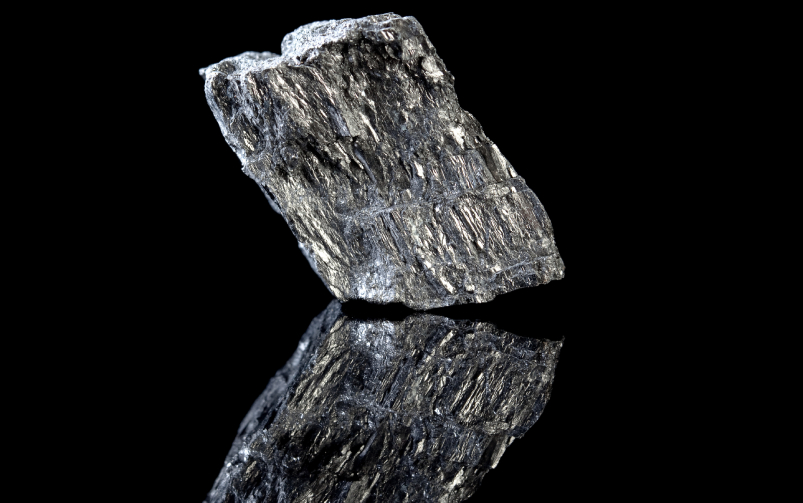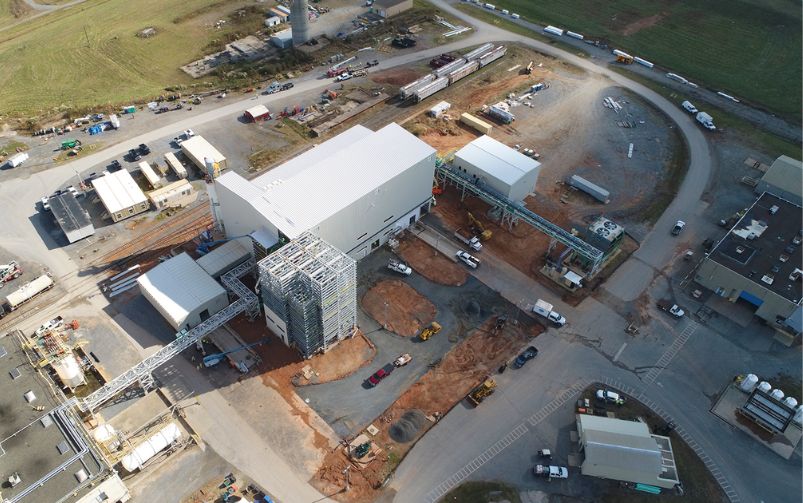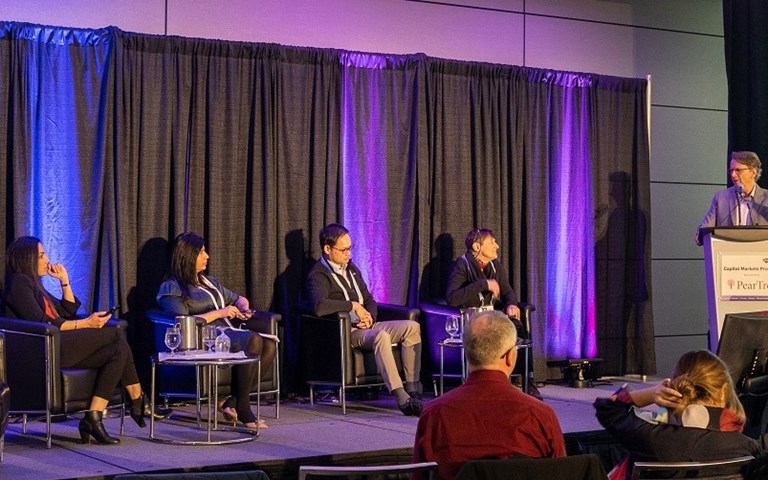(L-R) The investor panel Neelam Brar, Sarita Mandanna, Josh Su and Catharine Farrow, and host Carl Weatherell. Courtesy of ReThink Mining.
Four mining entrepreneurs showcased technologies they said could speed up the decarbonization of the industry to a panel of investors at an event hosted by Canada Mining and Innovation Council (CMIC) during the Prospectors and Developers Association of Canada’s 2023 convention in Toronto.
The ReThink Mining event was aimed at speeding up the implementation timeline for potential game-changing technologies by connecting companies with investors.
The investors panel included Catharine Farrow, a director at Franco Nevada and the former founding CEO and director of TMAC Resources; Josh Su, principal of BHP Ventures; Sarita Mandanna, partner at the Business Development Bank of Canada’s industrial innovation fund; Neelam Brar, managing director of venture at RoyNat Capital; and Luke Mahony, head of technology and innovation at Vale.
“Technology is going to play a pivotal role in addressing the challenges [mining faces],” said Carl Weatherell, executive director and chief executive officer of CMIC, at the event. “But many of these technologies don’t exist yet, and the timeline to create them is far too long. … The way we traditionally develop and commercialize technology has to change.”
Weatherell noted some new technologies can be difficult to adapt into existing mining processes, or face resistance from companies comfortable with the way things have always been done.
Gillian Holcroft, president of ReThink Milling in Montreal, pitched the panel on the company’s conjugate anvil hammer mill (CAHM) and monoroll technologies, which aim to significantly reduce the carbon footprint of comminution.
The CAHM, which is currently being tested at the COREM research centre in Quebec, is currently able to process 50 tonnes of ore per hour. ReThink Milling’s baseline testing has shown the machine, only a first prototype, has three times’ better energy consumption in comparison to a similar capacity high-pressure grinding roll. The monoroll, meanwhile, is a retrofitted vintage two-tonne ball mill from 1935 with patented liners and a specialized gear system, which Holcroft said is already showing a 25 per cent energy improvement over a traditional ball mill.
Comminution consumes about three per cent of global electric energy, and over 50 per cent of that is consumed by crushing and grinding, Holcroft said.
Holcroft said the CAHM could operate alone in the future and replace semi-autonomous grinding mills and crushers, and the monoroll could replace a ball mill. When the two are operated as a circuit, she said it “greatly simplifies the whole flow sheet. We don’t need pebble crushers, we don’t need all this auxiliary equipment, which means the capital and operating costs for new projects would go down substantially.” ReThink Milling also predicts the two-part circuit could result in an up to 65 per cent energy reduction.
ReThink Milling is now working with nine major mining companies – including Agnico Eagle Mines and Teck Metals – to advance the technology and is planning to test the CAHM at a mine site by mid-2024.
Related: New technologies are on the horizon to help miners process minerals more efficiently using less energy
Former Anaconda Mining president and CEO Dustin Angelo pitched his new company Novamera Inc.’s surgical mining technology, which integrates into conventional drilling equipment to pinpoint, map and extract ore from narrow vein deposits.
The company uses a guidance tool with 3D imaging to map an ore body’s geometry in high resolution and build a drilling trajectory. The data is fed into Novamera’s position control system and course-correction devices, which are fitted onto a conventional drill rig. “Essentially we’re taking a standard drill, making it smart and allowing it to follow that trajectory…so it can take up only ore and leave the waste behind.”
Novamera, which is a portfolio company in BDC’s industrial innovation fund, emerged from Anaconda’s struggle to mine what it considered its “holy grail,” – the high grade, steeply dipping narrow vein Romeo and Juliet deposit just up the road from the company’s Point Rousse open-pit gold mine in Newfoundland. “It was worth about $100 million to us, and it was our answer to more production and more profitability,” he said.
Angelo and Allan Cramm, formerly a technical advisor at Anaconda and now the vice-president of innovation at Novamera, took their idea for what they then called “sustainable mining by drilling” to the 2019 Disrupt Mining contest at PDAC, where it was named a runner up. But Angelo said the experience was an “aha” moment.
“We realized that we weren’t the only ones with this type of problem, and there was an opportunity to unlock trillions in small-scale narrow-vein deposits that were uneconomic, essentially stranded, because of their size and their geometry,” he said. “These deposits are all over the world and…span many different types of metals, [including] energy transition metals.”
The company is currently raising a $10 million Series A funding round, which would finance a move from demonstration phase work to full commercialization.
Richard MacKellar, an adjunct professor at the University of British Columbia and a venture capitalist, pitched Glasspoint, a U.S.-based company using sunshine to create steam. The company installs large, curved mirrors inside an agricultural greenhouse, which track the sun throughout the day and focus it on a boiler containing water. The sunlight then heats the water and produces steam for heat.
The company’s technology is being employed at Rio Tinto’s Yarwun aluminum refinery in Australia to create steam at a temperature of 290 degrees Celsius for the first stage of refining, which converts bauxite to aluminum hydrate.
Unlike electricity, heat has been quite difficult to decarbonize, MacKellar said. But it represents a significant opportunity: roughly $444 billion of coal, oil and gas are purchased every year worldwide for heating. “There are very few paths to really decarbonize the industrial heat market, and this is one that can do it today and at scale,” he said.
Paris Smalls, co-founder of Eden GeoPower in Boston, pitched the company’s electrical stimulation technology, which is meant to increase subsurface permeability with low environmental impact and could have uses in mining, geothermal heat recovery and other industries. The company received more than US$3.5 million in November from the U.S. Department of Energy’s Advanced Research Projects Agency.




